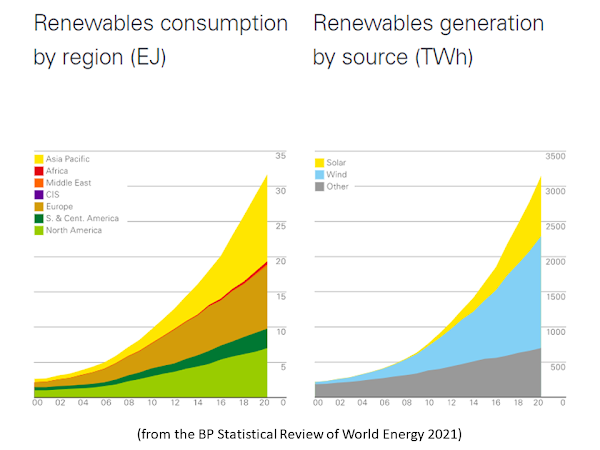Big Oil Faces Big Rise In Global New Energy
Highlights From The BP Statistical Review Of World Energy 2021
Robert Rapier, July 11, 2021 (Forbes)
“…[Typically comprehensive summary of energy trends, disruptions by COVID make the BP Statistical Review of World Energy 2021 less indicative] of these trends…[Oil demand fell dramatically last year, but] has largely recovered…Primary global energy consumption fell by 4.5% last year, which was the largest annual decline since 1945. About three-fourths of the decline came from oil…Small declines were also reported in coal, natural gas, and nuclear consumption, while renewables and hydropower recorded gains…[Oil still had] a 31.2% share of all energy consumption…[followed by] coal (27.2%), natural gas (24.7%), hydropower (6.9%), renewables (5.7%), and nuclear power (4.3%)…
…[Fossil fuels] accounted for 83.1% of the world’s primary energy consumption in 2020…There were consumption declines in over 95% of the countries, and] the U.S., India, and Russia contributed the largest annual declines…China was one of the rare exceptions, growing energy consumption by 2.1% over 2019. Still, that was well below China’s 3.8% average growth over the previous 10 years…Global carbon dioxide emissions fell by 6.3% in 2020…[This was] the largest decline since 1945… Despite the massive decline in global energy demand, global renewable energy consumption grew by 10% in 2020…
…Solar capacity increased by 127 gigawatts (GW), while wind capacity grew 111 GW. The growth in wind capacity was nearly double the highest prior annual increase. Together, wind and solar power now have a global capacity of 1,441 GW…[In 2010, it was 221 GW…China was the largest individual contributor…Nuclear consumption fell in 2020 by 4.1%...[I]t's more than obvious that the growth story for wind and solar power has many years to run. This will be especially true if the world continues to electrify its transport systems as expected…” click here for more


 click to enlarge
click to enlarge click to enlarge
click to enlarge click to enlarge
click to enlarge





0 Comments:
Post a Comment
<< Home